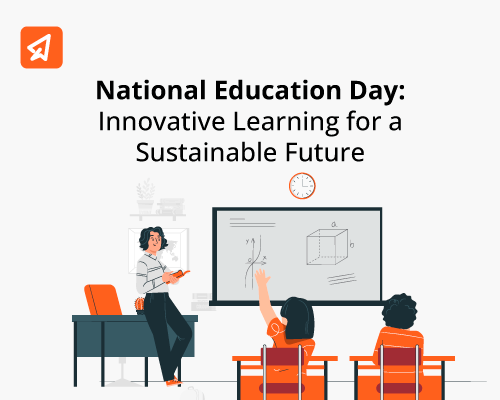IoT in Education – The Various Aspects and Advantages

Innovative digital technologies have proved to be immensely helpful in learning activities. Schools, colleges, and universities worldwide are quickly adopting IoT to create interactive and efficient learning methods for their students. However, teachers and school principals must understand and appreciate the utility of IoT in the education sector. If teachers understand the impact they can create by using the Internet of Things to integrate smart classroom solutions, they can make a significant difference in the education industry.
The first step to using IoT is understanding what IoT is in education and how it is used. Read on to know more.
What is IoT?
IoT, or the Internet of Things, is a digital technology that enables objects like speakers, lights, and home appliances to interact with smartphones and laptops through applications run on Internet technology. IoT technology aims to make our lives easier by automating mundane activities. If a device is connected to the internet and can transmit information, it is known as an IoT smart device.
What is IoT in Education?
IoT in education refers to the integration of Internet of Things devices and technologies into learning environments to enhance teaching and student experiences. It involves using connected devices like sensors, smart boards, and wearables to collect data, streamline processes, and create interactive learning opportunities, ultimately, it helps make learning more fun and effective for everyone involved.
How IoT Impacts the Education Sector?

As schools go through digital transformation, we see new hardware and software making their way to the classroom. As teachers, educators, or school leaders – you need to make it simple for these objects and apps to interact with one another and transmit information. That’s where IoT comes in. Wi-Fi-enabled IoT devices and smartphone applications can work in sync to make it effortless for schools and teachers to use them in the classroom. Here are the benefits of leveraging IoT in education –
- Improved Access to Learning – IoT enables educational institutions to offer easy access to learning from anywhere globally. Building a connected education experience also allows teachers to network and learn from each other. Similarly, students can work in groups irrespective of their geographic location.
- IoT Aids Resource Management – Effective resource management is challenging for every educational institution. Integrating IoT into your institution’s systems can improve the optimisation and conservation of resources.
- Real-Time Data Processing – IoT devices in education enable educators to collect accurate data about how their students interact with the devices and applications provided to them. Analysing this data can help you understand more about a student’s learning needs, progress, and interests. Such insights are vital for institutions that wish to provide personalised learning experiences.
- Efficient Management & Administration – IoT can help your institution automate several management and administrative tasks. Automation helps ensure efficiency and accuracy in fund distribution, tracking supply management, maintaining student records and other management tasks.
- Smart Security Solutions – IoT offers numerous security solutions for keeping your school campus safe and secure. Surveillance cameras, vaping sensors, video monitoring tools, and tracking devices linked to the internet can help you maintain decorum and safety in your institution.
- Aiding Research – Research enables students to learn concepts better, especially in subjects that require a deeper understanding. Advanced technologies offer students new methods to learn certain concepts via in-deapth research. And, IoT makes research a much easier process than before.
- Operating Cost – There are numerous operating costs involved in running an educational institution. The infrastructure consumes energy for heating, electricity, transportation, etc. You can use IoT to minimise the operating costs in your institution. IoT solutions like smart air conditioning, ventilation equipment, temperature sensors, and smart heating solutions can help reduce energy consumption.
- Inclusivity for Disabled Students – IoT offers various solutions for students with disabilities. You can provide smart devices to help students with disabilities to learn alongside other students. It will help project an inclusive and tolerant image for your educational institution.
Examples of IoT Devices & Their Application in Education
Schools worldwide have given up the black and white board to work with LED screens and projectors. In their time, these devices raised the bar to create smarter classrooms. But now, IoT devices can help educators to do more and build smarter learning experiences.
- Video-Enabled Learning – Learning with the help of video aids includes two things – learning through pre-recorded videos and attending a live online class through a video call. You can collaborate with experts worldwide to create video learning resources for your school. Teachers across India have successfully utilised Extramarks Smart Class Plus, a smart classroom solution that uses video-based learning to enhance traditional pedagogical methods.
- Smart Pen Scanner – A smart pen scanner can quickly scan images and text from books and documents. The scanned information can then be printed or displayed on a screen.
- Interactive Learning Devices – IoT devices such as virtual reality goggles or mobile devices can help create an interactive learning experience for students. Teachers can offer a guided tour of a historical site in augmented reality for an interactive history lesson.
- Instant Feedback – Most IoT devices enable institutions to get instant feedback from students and employees. Real-time communication can help educators facilitate their lessons per their learners’ needs.
- Webcams in Classrooms – Webcams enabled by IoT can do more than monitor student behaviour and activities. Teachers can use webcams to broadcast lectures and create virtual classrooms.
- Voice-to-Text Technology – Taking notes is quicker and easier if students use voice-to-text technology. Teachers and students can use voice-to-text technology to make notes efficiently when perusing new learning material.
- Smart Boards, Textbooks, & Classrooms – Smart boards are an interactive touch screen display that uses smart pens and touch to make teaching more efficient. Similarly, modern schools are adopting tablets with apps instead of textbooks and building smart classrooms using interactive IoT devices.
Popular Applications Within IoT Education
- Attendance Systems – Biometric attendance systems for school students and employees can automate a school’s attendance management function. Networked biometric systems such as fingerprint scanners, face scanners or retinal scanners can help record and report the attendance for your institution.
- Screen Readers – Visually challenged students may not benefit from installing smart screens in a classroom without screen readers. Screen readers convert the written material on the smart board or screen to enable visually impaired students to read.
- Remote Monitoring & Early Detection – Wearable health devices can help record and analyse a wide range of physiological data, such as heart rate, sleep patterns, pulse, and physical activity.
- Contactless Payments – Contactless payments help institutions offer their students many fee payment channels. Even if the students are not in the same city or country, they can make timely payments.
- Foreign Language Training – IoT-enabled applications can help create an immersive environment for learners of foreign languages. Schools can use these applications to offer students the required support for exchange programs in other countries.
- Remote Learning – IoT devices enable students and teachers to connect and continue learning irrespective of geographic location. Remote learning applications also enable self-learning and distance learning more effectively for institutions.
- Task-Based Learning – Institutions can enhance their education experience by creating task-based stimuli for conceptual learning. IoT apps also allow students to share their thoughts and collaborate for task-based learning.
There are several benefits of using IoT in the education sector. Due to cost constraints, educational institutions often shy away from installing the latest IoT applications in education. Fortunately, schools can partner with Extramarks to get their students the best IoT technology.
At Extramarks, our teams leverage the latest education technology and devices to create classroom solutions for the 21st century. Our Smart Class Plus is designed for the new-age classroom equipped with smart classroom technology, the Teaching App, the Learning App, as well as the Exramarks Parent App. It is an all-encompassing solution to help schools provide personalised learning for better engagement and results.
The ultimate solution for the new-age classroom that empowers you to teach effectively.
- Smart Classroom
- Teaching App
- Learning App
- Parent App
Last Updated on October 17, 2024
Reviewed by

Priya Kapoor | AVP - Academics
Priya Kapoor is an accomplished education professional with over 18 years of experience across diverse fields, including eLearning, digital and print publishing, instructional design, and content strategy. As the AVP – Academics at Extramarks, she leads academic teams in creating tailored educational solutions, ensuring alignment with varied curricula across national and international platforms...read more.










